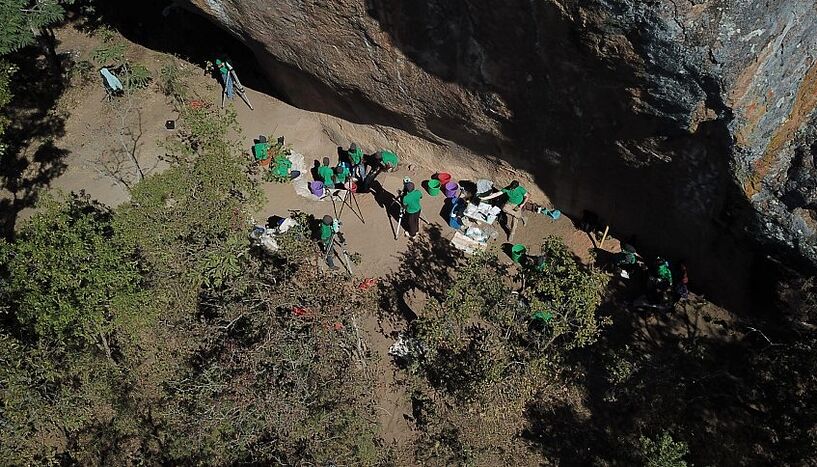Ancient DNA reveals surprises about how early Africans lived, traveled and interacted
23. Februar 2022
Hora Rockshelter in Malawi, where recent excavations uncovered two of the individuals analyzed in a collaborative study of ancient DNA. (© Jacob Davis)
New research provides evidence of demographic shifts in sub-Saharan Africa
A new analysis of human remains that were buried in African archaeological sites has produced the earliest DNA from the continent, telling a fascinating tale of how early humans lived, traveled and even found their significant others. An interdisciplinary team of 44 researchers with participation of Ron Pinhasi from the University of Vienna, reports its findings in "Ancient DNA reveals deep population in sub-Saharan African foragers." The paper was published today in Nature and reports findings from ancient DNA from six individuals buried in Malawi, Tanzania and Zambia who lived between 18,000 and 5,000 years ago.
The newly discovered aDNA from the six individuals more than doubles the antiquity of reported ancient DNA data from sub-Saharan Africa. In addition to that the researchers also reanalyzed published data from 28 individuals buried at sites across the continent, generating new and improved data for 15 of them. The result was an unprecedented dataset of DNA from ancient African foragers — people who hunted, gathered or fished. Their genetic legacy is difficult to reconstruct from present-day people because of the many population movements and mixtures that have occurred in the last few thousand years. Thanks to the new groundbreaking data, the researchers were now able to outline major demographic shifts that took place about 80,000 to 20,000 years ago. "We can always detect earlier patterns based on younger data. What we see in samples dated 18,000-5,000 years ago we can relate to the known population patterns dated to 80,000-20,000 years ago", Pinhasi explains.
As far back as about 50,000 years ago, people from different regions of the continent moved and settled in other areas and developed alliances and networks over longer distances to trade, share information and even find reproductive partners. This social network helped them survive and thrive, the researchers wrote.
The study provides a better understanding of how people moved and mingled in sub-Saharan Africa. Previously, the earliest African DNA came from what is now Morocco, but the individuals in this study lived as far from there as Bangladesh is from Norway. The new results now reveal the pattern of more local behavior in eastern Africa over time. "Our data adds weight to archaeological evidence for changes in the range of social networks at around 12,000 years ago following the onset of the Holocene. Prior to this period people travelled great distances to find partners from a wide range of geographic and cultural pools. But following major environmental and behavioral changes these groups established regional interaction spheres", said Pinhasi.
There are arguments that the development and expansion of long-distance trade networks around this time helped humans weather the last Ice Age. "Humans began relying on each other in new ways," Mary Prendergast, lead author of the paper and associate professor in anthropology at Rice University in Houston, said. "And this creativity and innovation might be what allowed people to thrive." The researchers were also able to demonstrate a shift that took place approximately 20,000 years ago, when people stopped moving around so much. One possible explanation could be, that at that point, previously established social networks allowed for the flow of information and technologies without people having to move.
Another exciting discovery: During this timeframe a dramatic cultural change took place, as beads, pigments and other symbolic art became common across Africa. Researchers long assumed that major changes in the archaeological record about 50,000 years ago reflected a shift in social networks and maybe even changes in population size. However, such hypotheses have remained difficult to test. The ancient DNA was the missing part of this puzzle – until now. "Ancient DNA provides direct insight into the mating and admixture of the people themselves, while artifacts like stone tools and beads tells us about exchange and interactions, which may, or may not, entail admixture. When these two aspects are combined, we can derive a much more comprehensive perspective about major patterns of Sub-Saharan Africans. This perspective is fundamental to the story of modern human dispersals within Africa and out of Africa and then the colonization of Eurasia, Oceania and beyond", said Ron Pinhasi.
The research team included scholars from Austria, Canada, Kenya, Malawi, Tanzania, the United States, Zambia and many other countries. Critical contributions to the study came from curators and co-authors at African museums who are responsible for protecting and preserving the remains. There are around 30 times more published ancient DNA sequences from Europe than from Africa. Given that Africa harbors the greatest human genetic diversity on the planet, there is still much more to learn.
Original publication:
Prendergast M., Pinhasi R. et al: "Ancient DNA and deep population structure in sub-Saharan African foragers", In: Nature (2022)
DOI: 10.1038/s41586-022-04430-9
Pictures:
Abb. 1: Hora Rockshelter in Malawi, where recent excavations uncovered two of the individuals analyzed in a collaborative study of ancient DNA. (© Jacob Davis)
Abb. 2: Hora Rockshelter in Malawi, where recent excavations uncovered two of the individuals analyzed in a collaborative study of ancient DNA. (© Jacob Davis)
Abb. 3: The Livingstone Museum in Zambia, where some of the skeletal remains in the study are curated. (© Livingstone Museum)
Wissenschaftlicher Kontakt
Ron Pinhasi, PhD
Department für Evolutionäre AnthropologieUniversität Wien
1090 - Wien, Althanstraße 14 (UZA I)
+43-1-4277-547 21
+43-664-60277-547 21
ron.pinhasi@univie.ac.at
Rückfragehinweis
Mag. Alexandra Frey
Media Relations ManagerUniversität Wien
1010 - Wien, Universitätsring 1
+43-1-4277-17533
+43-664-8175675
alexandra.frey@univie.ac.at
